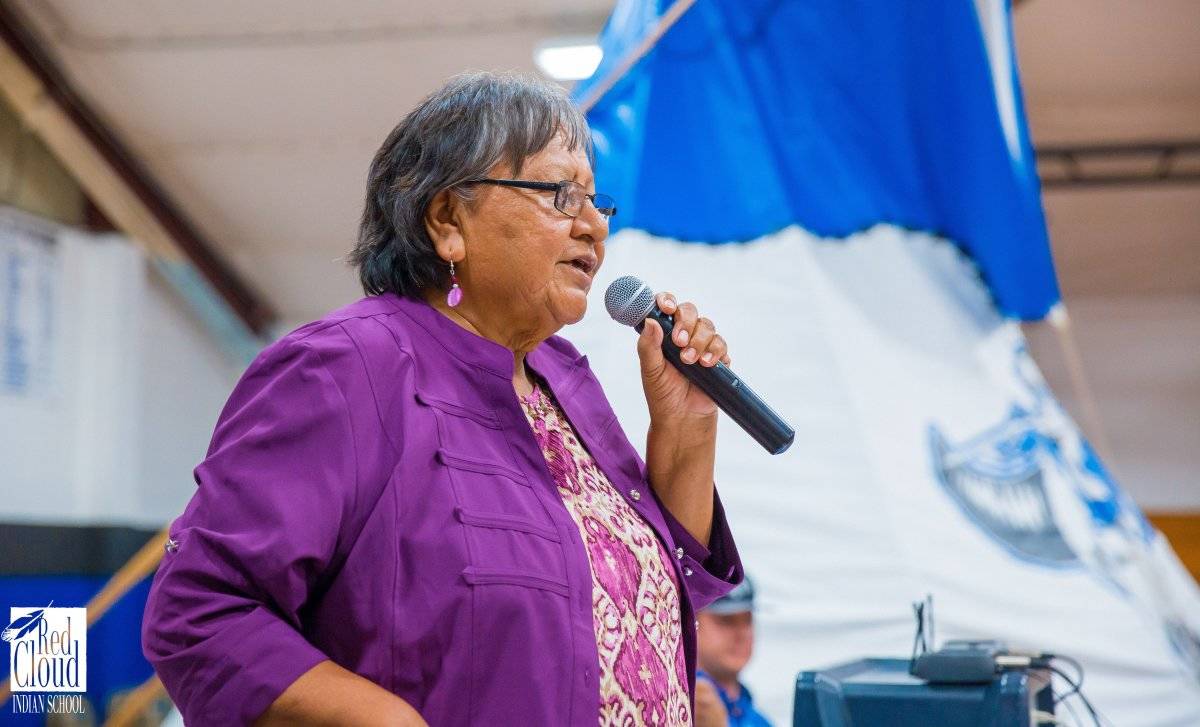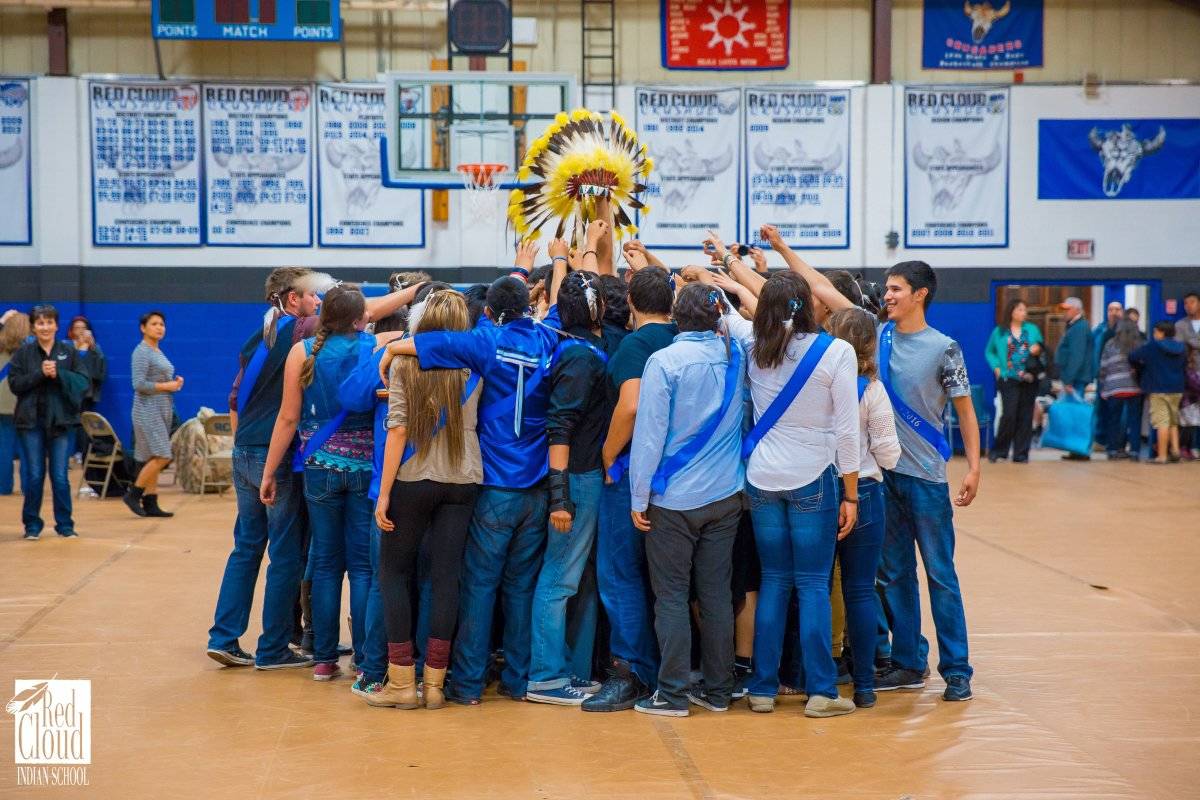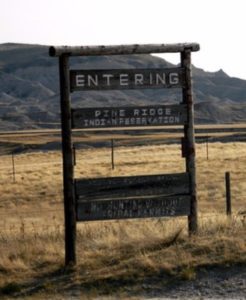As the sun set through the windows of the retreat center, four brave seniors shared their stories. “What obstacles have you faced in your life?” was – and has been for years – the prompt for this first night of sharing on the Red Cloud High School spring senior retreat. This year, as the four spoke their turns, their classmates listened in different ways, some covering their face in their hands, some crying their way through boxes of tissues, some staring out the window, and some getting out of their chairs to cradle the speakers in their arms, themselves sobbing through the final words of their testimonies.
The hour ended with many hugs and a break before going into small groups around the same question, “What obstacles have you faced in your life?” One student, somehow simultaneously sobbing and laughing, asked me, the new campus minister, “Did you bring enough tissue?” Numbering fifty-ish students, I figured seven boxes would be enough…
It was – just barely.
***
With enough communal trust, with enough security in the retreat space, and with four heart-tearingly vulnerable speakers, the question “What obstacles have you faced in your life?” could melt the hardest of hearts, knock down the tallest of barriers, and open wide the shuttest of souls to deep and intimate sharing – no matter what ethnic or socioeconomic background the group. But without violating any of that sacred space’s confidentiality, the stories courageously shared and communally received on this retreat spoke to some of the greatest challenges of Lakota life on the Pine Ridge Reservation, or more generally, the greatest challenges of Native American life on this continent ever since Columbus.
But the stories didn’t end like this.
The retreat didn’t end like this.
Nor can we let conversations about Pine Ridge end like this.
Conversations about the Pine Ridge Reservation often begin: “Wow, that’s a really tough place – pretty poor, huh? It’s just so sad.”
But I’m tired of conversations about Pine Ridge ending like this. If you want obstacles, if you want statistics or photographs about “poverty,” statistics on chemical dependencies and suicides and life expectancies, go ahead; go find them, indulging whatever hunger it is that compels such searching. But then come back. Please come back. Keep reading. Come back for the second half of their stories, come back for the second half of the retreat: “How have you overcome your obstacles?” Come back for the stalwart beating heart that has kept this culture defiantly alive through a horrible history.
***
After the four student speakers poured out their stories, we broke into small groups. The sharing was equally intense, equally challenging, equally cleansing. Sitting by the brick fireplace, my small group’s students took turns holding each others’ hands while they shared stories and tears. Some needed to step out, asking to “get some air.”
Go ahead.
I took solace that these students were stepping out from one safe space into an even safer space: four Lakota men, relatives and friends of some of the students, also stood out on that deck, patiently waiting. They are our guests for the next part of the retreat. I hear them talking to the students who stepped out.
I’m so glad that they’re here.
***
I don’t know much about anthropology, but I know just enough. Every culture has its way of celebrating and mourning; each culture has ways to welcome life, heal it, and send it on. These things are ritualized, blurring boundaries: Is this a social gathering? A cultural ritual? A spiritual ceremony? Not sure, but it’s a medicine for the people.
Adjourning the small groups, we gathered again and the waiting men now began to speak, introducing the prayer they came to lead. The men, a Lakota drum group, started singing traditional prayer songs as they purified the dim space with burning sage from an abalone shell. Following one of the men, the students gathered their feelings and offered their heavy obstacles and partnered hopes as prayers in palmfuls of tobacco tied into “flags” of red, yellow, white and black cloth. The next day they would hike to a high point to tie these flags in trees in the sacred Black Hills; each would be offered as collective prayers to Creator God, who in Lakota can be called Wakháŋ Tháŋka (Great Mystery) or Thuŋkášila (Grandfather).
With the flags set aside for the next day’s hike, someone flipped the lights, stoked the fireplace, and the drum group began again.
But this time, the drumming sounded different – even to a rookie’s ears; it sounded lighter, brighter and even celebratory.
Two of the seniors stepped forward and called their classmates together for four traditional line dances – partner-stepping, bridge-building, and wildly snaking everyone around the room. Laughing, sweaty, and completely exhausted, they then broke into the cool, dark night across the field to their cabins for bed.
But, of course, they’re high schoolers – they (somehow) didn’t actually sleep for a couple more hours.
***
I can’t entirely blame people when the first thing they say when I tell them I’m working on the Pine Ridge Reservation is something about poverty or struggle or alcoholism. I can’t blame them when that’s the only narrative the New York Times or National Geographic cares to tell, fixated on “poverty” as if it’s pornography, discussing Indian issues as if they’re exotic tourist attractions for the American West. Go find those statistics if you want, but I refuse to talk about “poverty” here without first talking about robbery. A Lakota elder in our school community told me as I drafted this piece, “I hate it when they label us (the Pine Ridge Oglala Nation) the poorest and the filthiest… Why can’t America say, ‘This is the product of our colonialism… this is what we have done?’”
***
In these last ten months on Pine Ridge, my job description has been campus minister and teacher. No matter how proud I am of how much I’ve grown in these things, my biggest learning curve this year has been my invigorating and ongoing re-education about the Lakota people and about this place of Pine Ridge. Sharing in ceremonies or dances, dinners and hours-long conversations, I’ve been able to give flesh to the skeletal TED talks, NYT articles, and books I consumed before coming. There is so much to learn, from adults and students alike. While I feel utterly disconnected from my German familial roots, for example, I am deeply moved and challenged by students here who claim and fiercely wield their Lakota cultural riches from faith to family to language to song to dance to art to ritual to respect and righteous anger about what America has done to Native Americans.
To think, the drum songs, the dances, the tobacco-tying prayer and purifying sage, the language that fills thick dictionaries and students’ texts and hallway conversations and more, to think that every little piece of what it meant and what it means to be proudly Lakota, was for a time savagely repressed.
To think, all of these medicines in times of mourning and springs in times of victory, every little piece of this was beaten out of my seniors’ great-grandparents in the name of “killing the Indian to save the man,” in the name of “progress,” in the name of “Manifest Destiny” and most horrifyingly for me, in the name of God.
To think, the same prayer rites and songs so central to this spring’s senior retreat were illegal, in some cases punishable by death, until the 1970s.
I cannot, I will not talk about poverty here until we talk about robbery first, until we talk about how cavalries and captains, miners and railroad men, religious sisters and brothers, priests and teachers, presidents and politicians all played roles in a systematic cultural robbery – a terrible heist, a suppression and genocide that lives on in the boundaries of reservation lands, profits from stolen lands, continues as trauma in even youthful hearts and minds. But even this conversation I will cut short. My seniors’ stories have another page, the retreat has another day. It’s something they call perseverance or strength and something that I call hope.
***
On the final night of the retreat, we gathered in the same, dark room around a bright, flickering flame and 60 unlit candles placed around it. We gathered to pray in gratitude, mindful both of the obstacles and how they were overcome. Beside our obstacles we set the families of faces who helped us overcome them. One by one, each student lit their candle from the others, speaking the name of the person who kept them going.
As I sat and watched the light in the center of the room grow, I saw more and more of the students’ faces. I pictured more and more of their parents and aunties’ and grandparents’ and sisters’ and brothers’ faces. In this sea of faces, I couldn’t help but think that yes, while these graduating seniors are indeed “the future,” they are also the past, bearing within them all the past’s glory but also its tragedy. I can’t help but think now that both the glory and the tragedy has strengthened them; both the glory and the tragedy will fuel this torch that they will take forward.

An elder and Red Cloud High School teacher speaking to graduating seniors about a cultural dance, photo by Willi White
I’m missing the point if I only consider obstacles like poverty. I’m also missing the point if I only talk about the terrible backstory of these obstacles, the criminal generations of genocide. When I’ve slowed down enough to hear a student’s life story as they tell it, I hear that the obstacles and the crimes behind them are not forgotten but wrapped up in something new, something greater: a hope formed by the past for the future, a hope forged in trials but lunging toward good tomorrows. All with the strength of relatives, living and deceased; all with the power of ceremonies, prayers and rituals, once illegal and now resurging.
In the end, I’m just a visitor here and I don’t really know what I’m talking about – but I’ve had the privilege of listening to some people who really do know what they’re talking about. And they’re about to graduate high school. I will celebrate them with all I’ve got, mindful not only of their ancestors’ challenges but their own, mindful not only of their ancestors’ triumphs but their own, perhaps the least of which is inspiring and growing my mind and heart three sizes.
Thank you, Red Cloud High School class of 2016. You’ve been my students, but also my best teachers.
— // —
This post is part of a series in preparation for Magis 2016, a gathering of young adults before World Youth Day in Poland. Pope Francis has offered participants a series of twelve questions for their preparation. Check out the Magis website to see how others are responding to the question, “How do you understand the “poverty” of people in your community (family, school, neighborhood, parish)?”



